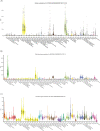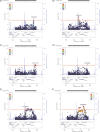Genetic analysis of the PCSK9 locus in psychological, psychiatric, metabolic and cardiovascular traits in UK Biobank
- PMID: 35501368
- PMCID: PMC9712543
- DOI: 10.1038/s41431-022-01107-9
Genetic analysis of the PCSK9 locus in psychological, psychiatric, metabolic and cardiovascular traits in UK Biobank
Abstract
The association between severe mental illness (SMI) and cardiovascular and metabolic disease (CMD) is poorly understood. PCSK9 is expressed in systems critical to both SMI and CMD and influences lipid homeostasis and brain function. We systematically investigated relationships between genetic variation within the PCSK9 locus and risk for both CMD and SMI. UK Biobank recruited ~500,000 volunteers and assessed a wide range of SMI and CMD phenotypes. We used genetic data from white British ancestry individuals of UK Biobank. Genetic association analyses were conducted in PLINK, with statistical significance defined by the number of independent SNPs. Conditional analyses and linkage disequilibrium assessed the independence of SNPs and the presence of multiple signals. Two genetic risk scores of lipid-lowering alleles were calculated and used as proxies for putative lipid-lowering effects of PCSK9. PCSK9 variants were associated with central adiposity, venous thrombosis embolism, systolic blood pressure, mood instability, and neuroticism (all p < 1.16 × 10-4). No secondary signals were identified. Conditional analyses and high linkage disequilibrium (r2 = 0.98) indicated that mood instability and central obesity may share a genetic signal. Genetic risk scores suggested that the lipid-lowering effects of PCSK9 may be causal for greater mood instability and higher neuroticism. This is the first study to implicate the PCSK9 locus in mood-disorder symptoms and related traits, as well as the shared pathology of SMI and CMD. PCSK9 effects on mood may occur via lipid-lowering mechanisms. Further work is needed to understand whether repurposing PCSK9-targeting therapies might improve SMI symptoms and prevent CMD.
© 2022. The Author(s).
Conflict of interest statement
The authors have no competing interests.
Figures




Similar articles
-
Genetic architecture of DCC and influence on psychological, psychiatric and cardiometabolic traits in multiple ancestry groups in UK Biobank.J Affect Disord. 2023 Oct 15;339:943-953. doi: 10.1016/j.jad.2023.07.052. Epub 2023 Jul 22. J Affect Disord. 2023. PMID: 37487843
-
Genetic Variation in the ASTN2 Locus in Cardiovascular, Metabolic and Psychiatric Traits: Evidence for Pleiotropy Rather Than Shared Biology.Genes (Basel). 2021 Jul 31;12(8):1194. doi: 10.3390/genes12081194. Genes (Basel). 2021. PMID: 34440368 Free PMC article.
-
Genetic variation in circadian regulator gene BMAL1 in psychiatric, psychological and cardiometabolic traits: a trans-ancestry UK Biobank study.BMJ Ment Health. 2024 Dec 12;27(1):e301267. doi: 10.1136/bmjment-2024-301267. BMJ Ment Health. 2024. PMID: 39667926 Free PMC article.
-
Genetic Assessment of Potential Long-Term On-Target Side Effects of PCSK9 (Proprotein Convertase Subtilisin/Kexin Type 9) Inhibitors.Circ Genom Precis Med. 2019 Jan;12(1):e002196. doi: 10.1161/CIRCGEN.118.002196. Circ Genom Precis Med. 2019. PMID: 30645167
-
Nutritional and Lipid Modulation of PCSK9: Effects on Cardiometabolic Risk Factors.J Nutr. 2017 Apr;147(4):473-481. doi: 10.3945/jn.116.235069. Epub 2017 Feb 8. J Nutr. 2017. PMID: 28179493 Review.
Cited by
-
Mental Illness Strikes at the Heart: Impact of Psychiatric Diseases on Ventricular Ejection Fraction in Patients with Acute Coronary Syndromes.Life (Basel). 2025 Feb 21;15(3):340. doi: 10.3390/life15030340. Life (Basel). 2025. PMID: 40141685 Free PMC article.
-
Proprotein convertase subtilisin/kexin type 9 deficiency in extrahepatic tissues: emerging considerations.Front Pharmacol. 2024 Jul 30;15:1413123. doi: 10.3389/fphar.2024.1413123. eCollection 2024. Front Pharmacol. 2024. PMID: 39139638 Free PMC article. Review.
-
PCSK9 deficiency alters brain lipid composition without affecting brain development and function.Front Mol Neurosci. 2023 Jan 17;15:1084633. doi: 10.3389/fnmol.2022.1084633. eCollection 2022. Front Mol Neurosci. 2023. PMID: 36733269 Free PMC article.
-
Investigating the association of the effect of genetically proxied PCSK9i with mood disorders using cis-pQTLs: A drug-target Mendelian randomization study.PLoS One. 2024 Sep 26;19(9):e0310396. doi: 10.1371/journal.pone.0310396. eCollection 2024. PLoS One. 2024. PMID: 39325747 Free PMC article.
-
Investigating the potential impact of PCSK9-inhibitors on mood disorders using eQTL-based Mendelian randomization.PLoS One. 2022 Dec 29;17(12):e0279381. doi: 10.1371/journal.pone.0279381. eCollection 2022. PLoS One. 2022. PMID: 36580462 Free PMC article.
References
Publication types
MeSH terms
Substances
Grants and funding
LinkOut - more resources
Full Text Sources
Miscellaneous

